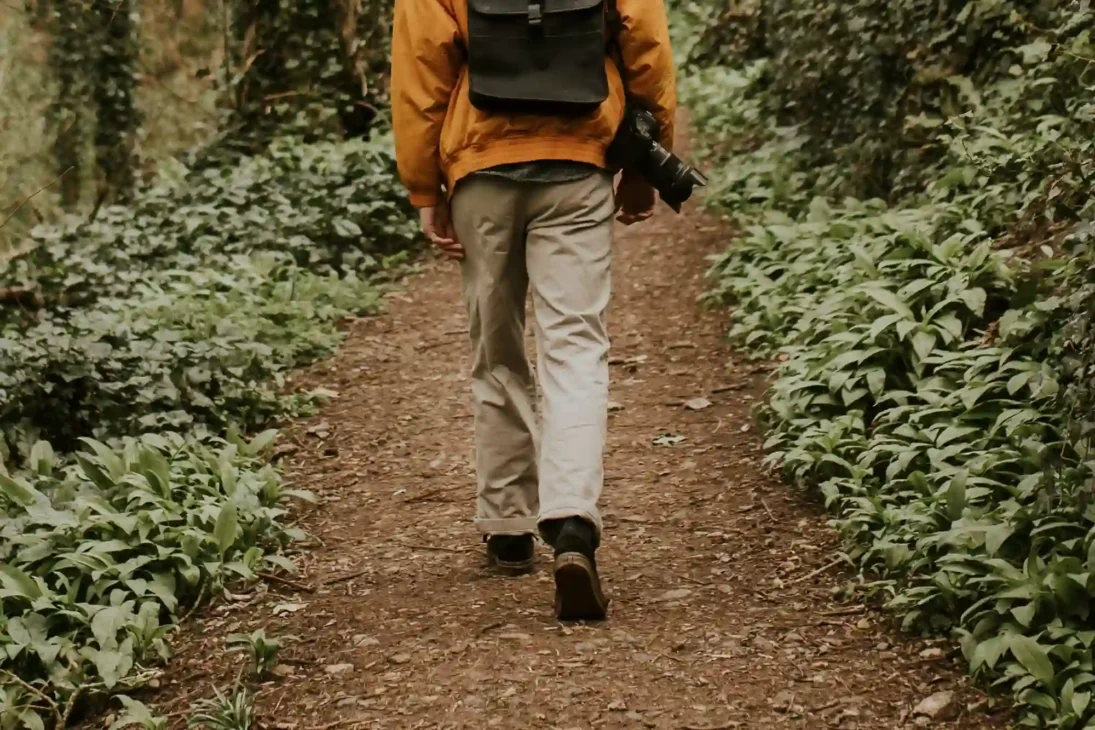Your Gentle Adventure Guide: 10 Low-Energy Outdoor Activities

Adventure doesn’t have to be extreme—it can be soft, slow, and deeply healing. Sometimes, it’s as simple as stepping outside at your own pace and letting nature work its quiet magic. These ten easy outdoor activities prove that calm can be its own kind of thrill, helping you reconnect with nature, lift your mood, and restore your energy—no mountain climbs, marathons, or packed weekends required.
Ready to step outside and find calm? Here are ten easy outdoor activities to help you reconnect with nature, lift your mood, and restore your energy. No need for lots of gear or a whole weekend.
1. Slow-Paced Nature Walks

Forget the stopwatch or fitness tracker. This isn’t about “getting steps in”—it’s about wandering with intention. Choose a nearby park, botanical garden, or riverside path. Walk slowly enough to notice the curve of a leaf or the sound of distant water. Slow-paced nature walks are one of the simplest and most restorative easy outdoor activities you can try.
According to Stanford researchers, walking in natural settings reduces rumination and lowers stress-related brain activity, making it a powerful yet gentle way to reset your mind and body.
Why it heals: Gentle walking helps your body in several important ways. It improves blood flow, which brings fresh oxygen and nutrients to your muscles, helping to ease any tension or stiffness. At the same time, it boosts the release of endorphins—natural chemicals in your brain that make you feel happy and relaxed.
This kind of slow-paced walking doesn’t strain your body or drain your energy. Instead, it signals your nervous system to shift away from the stress-driven “fight-or-flight” mode into a calmer “rest-and-digest” state.
Ways to make it fun:
- Do a “color hunt.” Look for three shades of green, two of blue, and one of yellow. Notice subtle variations you might usually miss.
- Pause often. Close your eyes, take deep breaths, and focus on the sounds around you. Listen for rustling leaves, bird calls, or distant water.
- Invite a friend to join you. Agree to walk in comfortable silence for part of the way. This lets you enjoy your own thoughts while sharing the moment.
When your feet slow and the world feels softer, settle down with a book and let the pages keep the wandering going.ok and let the pages keep the wandering going.
2. Reading Outdoors

Yes, this absolutely counts as an easy outdoor activity. You can set up a hammock, lie on a blanket in the park, or simply sit on your porch with a hot drink and a book. Let the rustle of leaves or the soft hum of distant chatter become your background music.
Why it heals: Being outside in the fresh air helps your body take in more oxygen, which naturally fuels your brain and keeps you alert and focused. Unlike caffeine or other stimulants, this natural boost is gentle, sustainable, and grounding. Reading outdoors gives your mind a break from everyday stress while quietly recharging your mental energy.
“I once brought a mystery book to the beach ‘just for an hour.’ Four chapters later, my shoulders had dropped, my jaw unclenched, and I realized I hadn’t checked my phone once—zero effort, full reset.”
Extra tips:
- Stay cozy. Bring a light scarf or blanket in case the wind picks up or the temperature drops while you’re reading.
- Read for joy. Choose a book that makes you feel good or sparks curiosity—reading should be a pleasure, not a task.
- Engage your senses. Pair your reading time with herbal tea or a fresh fruit snack for a comforting sensory layer.
And if turning pages feels too still, let your hands meet the earth through gentle gardening for a different kind of calm.t the earth for a different kind of calm.
3. Gentle Gardening

You don’t need a sprawling backyard to enjoy easy outdoor activities like gardening. Even a small row of herbs on your balcony, windowsill, or porch can be enough. Gardening is about connection—with the earth, the seasons, and yourself.
Why it heals: Touching soil, also known as earthing, is more than just getting your hands dirty—it’s been shown to reduce inflammation and improve sleep quality. This simple act of grounding helps calm your nervous system and reconnects you with the present moment. Beyond the physical benefits, gardening offers a quiet reward: you nurture something living without pressure or performance.
It’s a gentle way to slow down, care, and grow—for both your plants and yourself.
Plants to start with:
- Lavender – Its soothing scent helps reduce stress and promote relaxation. Use its fragrant blooms in tea or sachets for a calming touch indoors.
- Chamomile – Known for its gentle, comforting aroma, perfect for teas that calm the mind and body.
- Basil – Easy to grow, aromatic, and adds freshness to meals—making cooking a small joy.
Make it easier: Use gloves if you prefer clean hands, start with pre-potted plants instead of seeds, and keep a small watering can nearby for simple upkeep.
When you’re done tending your garden, pause. Feel the air, notice the soil, and breathe deeply.
Growth happens slowly—so do you.
4. Water Watching

You don’t have to live near an ocean to enjoy this one. Lakes, rivers, fountains, or even a simple backyard birdbath can offer the same sense of calm. Sit, breathe, and simply watch how water moves—ripples, waves, reflections.
Why it heals: The gentle rhythm of water—whether rippling waves, flowing streams, or a quiet fountain—has a naturally calming effect on the mind. Studies from UC Davis show that watching moving water can lower heart rate and promote relaxation, helping ease tension and slow down racing thoughts. In mindfulness and meditation, water is often used as a visual anchor to help you stay present, grounded, and mentally clear.
Ideas to try:
- Listen for the subtle difference between still water’s gentle lapping and flowing water’s soothing rush—both calm the senses in their own way.
- Observe how sunlight and shadows shift across the surface, changing the water’s color and texture throughout the day.
- Touch the water if you can—dip your fingers or feet in and feel its temperature, grounding yourself in the present.
When the reflections fade, lift your gaze—the sky is still putting on its own slow, beautiful show.
5. Cloud Gazing and Star Watching

Sometimes the best easy outdoor activities happen above our heads. During the day, find a grassy spot, lie back, and let your thoughts drift with the clouds. At night, spread a blanket, breathe deeply, and look for constellations sparkling in the quiet sky.
Why it heals: Gazing upward—whether at drifting clouds or distant stars—naturally slows your breathing and opens your posture, helping release tension from your neck and shoulders. Mindfulness experts note that shifting your gaze toward expansive views, like the sky, can reduce overthinking and foster emotional calm. The vastness above you gently reminds you that your worries are small compared to the infinite space stretching beyond sight.
This simple act invites awe, perspective, and deep relaxation.
Extra fun:
- Daytime: Play “cloud shapes,” naming what you see and letting your imagination roam—an easy way to rediscover childlike joy.
- Nighttime: Use a stargazing app to spot constellations and planets, turning the sky into your personal planetarium.
- Mood match: Pair the view with calming music or enjoy total silence for a meditative moment.
Once the sky has shared its stories, bring the magic back down to earth with a cozy picnic or quiet reflection. down with a cozy picnic.
6. Picnics with a Twist

You don’t need an Instagram-perfect spread for this one. Bring one comfort food, a drink, and a cozy blanket. This is one of those easy outdoor activities that invites you to choose somewhere you wouldn’t normally go—like the far end of a park, a quiet hilltop, or even your backyard at an unusual time of day.
Why it heals: Simply stepping into a different setting, even for just an hour, awakens your senses with new sights, sounds, and smells. This gentle shift in environment interrupts repetitive thought patterns and restores mental energy that’s often drained by routine. By giving your mind a fresh perspective, you naturally boost creativity, lift your mood, and return feeling recharged from the inside out.
Little upgrades:
- Bring one comfort food that feels like a treat—something that smells or tastes like a cozy hug.
- Write a postcard or short letter while you’re there; this little ritual turns a simple outing into a mindful moment.
- Try a sunrise picnic to start your day with stillness and light—watching the world wake up is its own kind of healing.
When the change of scene feels just right, let a short scenic drive or a quiet corner remind you: energy restoration doesn’t always mean rest—it can also mean rediscovery.
7. Short Scenic Drives

If walking isn’t calling to you today, try one of the easiest outdoor activities of all—let the road refresh you. Hop in the car, roll down the windows, play your favorite playlist, and watch the scenery shift as you move.
Why it heals: Driving through scenic routes engages your senses without demanding physical effort. The changing landscapes act as a natural reset button, easing repetitive thoughts and offering your mind a fresh perspective. This gentle rhythm of movement promotes calm, creativity, and emotional renewal.
Tips to make it special:
- Pick routes with minimal traffic so you can truly relax and enjoy the view.
- Bring a favorite snack or drink, and pull over at a peaceful spot to savor it slowly.
- Leave errands behind—make this a drive for you, not a to-do list on wheels.
If something catches your eye, stop safely and capture the small, beautiful details that make the journey worth it.
Safety note: Always follow traffic laws, stay alert, and pull over only in safe, legal areas.
8. Mindful Photography

Bring your phone or camera outdoors and focus on capturing small, beautiful details: morning dew on grass, the texture of bark, sunlight on water.
Why it heals: Focusing on capturing small, beautiful details trains your brain to be fully present and tap into creativity. This mindful attention helps reduce stress by shifting your thoughts away from worries and into the moment. Plus, creating a “visual diary” of these positive images gives you a collection of uplifting memories to revisit whenever you need a mood boost.
Make it intentional:
- Set a goal to capture five different textures. Examples include rough bark, smooth leaves, glistening water droplets, soft moss, or cracked earth. This helps train your eye to notice variety.
- Try a “no people” rule for your photos. Focus only on nature’s details. This gives you permission to slow down and appreciate subtle beauty.
- Create a small album—digital or printed—of your favorite shots. You can revisit these calming moments whenever you need a mood boost.
When you start framing the small wonders, you begin to see them everywhere.
After framing beauty, invite your body to join in—slow stretches or Tai Chi can match that calm.
9. Outdoor Stretching or Tai Chi
You don’t need a mat, gym, or complex routine. One of the easy outdoor activities you can try is to simply step outside, take a deep breath, and move slowly through stretches or follow a gentle Tai Chi video.
Why it heals: Moving slowly outdoors—whether through gentle stretching or Tai Chi—improves blood flow, eases tension, and clears the mind. Breathing in fresh air nourishes your body while calming your nervous system, creating a deep sense of relaxation. Research from Frontiers in Psychology shows Tai Chi can lower anxiety, improve balance, and support overall mental well-being, especially for older adults. This simple practice helps harmonize your body and mind without strain or pressure.
Helpful pointers:
- Move slowly and smoothly. Keep each stretch deliberate to maximize relaxation and prevent injury—there’s no need to rush.
- Sync your breath with movement. Use your inhale and exhale to guide each motion, letting your breath anchor your focus.
- Pick a peaceful spot. Practice where sunlight filters through trees or near soft natural sounds to deepen your sense of calm.
Once you feel centered and limber, wander through a quiet local market to carry that peace into the rest of your day.
10. Visiting Local Markets

Not all markets are bustling and loud—some, especially morning or farmers’ markets, offer one of the easiest outdoor activities with a peaceful, community-focused feel. Stroll at your own pace, people-watch, and maybe pick up a fresh snack or a handmade trinket.
Why it heals: Visiting local markets lets you connect with the people who grow and create your food and goods, fostering a warm sense of community and belonging. Exploring fresh produce, fragrant herbs, and handcrafted items engages your senses in a positive, grounding way. These simple, joyful interactions gently lift your mood and offer a meaningful break from everyday stress, making it a natural way to recharge emotionally and mentally.
Things to try:
- Smell different herbs and flowers before buying, letting your senses explore can be a surprising way to connect with nature and culture.
- Buy one ingredient you’ve never cooked with before and look up a simple recipe to try at home—turning shopping into a creative adventure.
- Chat briefly with a vendor about their work or favorite products; small conversations like these can brighten your day and deepen your sense of community.
And that’s number 10—proof that adventure doesn’t have to drain your energy to fill your soul. You don’t need to scale mountains or chase adrenaline to feel the spark of discovery and connection we all crave. Sometimes, the connection itself can be its own kind of adventure.
Why “Easy” Still Counts as Adventure
There’s a common myth that adventure must be extreme to be worthwhile. The truth? Adventure is about how you feel, not how far you go. It’s the spark of curiosity, the joy of discovery, and the sense of connection that make any experience an adventure—no matter the pace or distance. Even if you can’t travel far or take on big challenges, adventure is still possible.
“Adventure isn’t about intensity—it’s about intention.”
For those of us managing busy schedules, fatigue, or who simply prefer slower days, easy outdoor activities can still offer:
- A sense of discovery – Something as simple as finding a quiet path in your neighborhood or noticing sunlight filter through leaves can spark wonder. These small moments invite curiosity and make familiar places feel fresh and new.
- Physical movement without burnout – You’re still moving your body, improving circulation, and easing tension, but at a pace that honors your current energy levels. This mindful movement keeps you strong without draining you.
- Emotional release through connection with nature – Time outdoors naturally grounds you, calming racing thoughts and soothing anxiety. The steady rhythms of the natural world encourage emotional balance and mental clarity.
According to the American Heart Association, spending time outdoors can help reduce stress, improve mood, and support overall heart health—making it one of the simplest ways to care for both your body and mind, no extreme adventures required.
And that’s the heart of it: adventure doesn’t have to be loud or exhausting to be real. Sometimes, ease itself is the adventure.
FAQs
1. What are the best low-energy outdoor activities for stress relief?
Try gentle options like mindful walking, outdoor stretching, gardening, or visiting a local market. These activities reduce stress by combining light movement with nature’s calming effects, helping you unwind without draining your energy.
2. How long should I spend outdoors to feel recharged?
Even 20–30 minutes a few times a week can improve mood and lower stress levels, according to the American Heart Association. The key is consistency—regular short breaks outdoors can have lasting benefits for your mental and physical health.
3. Can I still benefit from these activities if I live in a city?
Absolutely. Urban green spaces, rooftop gardens, or quiet corners near trees or plants can offer the same benefits. What matters most is intention—taking a mindful pause in nature, even in small doses, can restore calm and focus.
4. Which gentle adventures are best for beginners or seniors?
Start with Tai Chi, slow-paced walking, or bird-watching. These activities are low-impact, safe for most fitness levels, and proven to support balance, mobility, and relaxation while keeping you connected to the outdoors.
5. What should I bring for a mindful outdoor experience?
Keep it simple: comfortable clothes, water, sunscreen, and your phone on silent. Consider bringing a small notebook to jot down reflections or a camera to capture moments that inspire peace and gratitude.
Adventure Is What You Make It
The beauty of easy outdoor activities is that they adapt to you, not the other way around. You don’t have to wait until you’re feeling 100% to step outside.
Even the smallest moments—watching the sunset, smelling rain on pavement, or hearing birds at dawn—can be powerful forms of natural energy healing.
If you’ve been telling yourself you’re “too tired” for adventure, maybe it’s time to redefine what adventure means for you.
Start where you are, with what you have—every step counts toward feeling alive again.
Whether you try just one or all ten ideas, remember: the beauty of adventure is in the moments you create, not the miles you cover. Your next story is waiting—go live it.
After all, sometimes the greatest adventures happen when you slow down enough to notice them.
Your challenge: Pick one thing from this list to try this week. Not because you should, but because you deserve to feel lighter, calmer, and more connected to the world around you.


